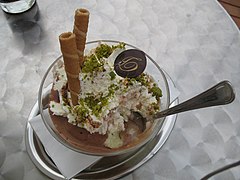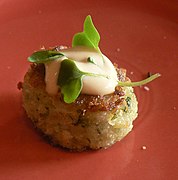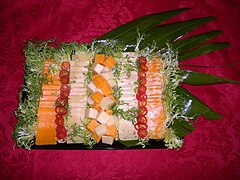
Garnish (food)

A garnish is an item or substance used as a decoration or embellishment accompanying a prepared food dish or drink. In many cases, it may give added or contrasting flavor. Some garnishes are selected mainly to augment the visual impact of the plate, while others are selected specifically for the flavor they may impart. This is in contrast to a condiment, a prepared sauce added to another food item primarily for its flavor. A food item which is served with garnish may be described as being garni, the French term for "garnished."
Many garnishes are not intended to be eaten, though for some it is fine to do so. Parsley is an example of a traditional garnish; this pungent green herb has small distinctly shaped leaves, firm stems, and is easy to trim into a garnish.
Overview
A garnish makes food or drink items more visually appealing. They may, for example, enhance their color, such as when paprika is sprinkled on a salmon salad. They may provide a color contrast, for example when chives are sprinkled on potatoes. They may make a cocktail more visually appealing, such as when a cocktail umbrella is added to an exotic drink, or when a Mai Tai is topped with any number of tropical fruit pieces. Sushi may be garnished with baran, a type of plastic grass or leaf. Sometimes a garnish and a condiment will be used together to finish the presentation of a dish; for example, an entrée could be topped with a sauce, as the condiment, along with a sprig of parsley as a garnish.
A garnish may be so readily identified with a specific dish that the dish may appear incomplete without the garnish. Examples include a banana split sundae with cherries on top or buffalo wings served with celery stick garnish and blue cheese dressing.
List of garnishes
Foods and entree
Garnishes for foods and entrees include:
- Amandine – a culinary term indicating a garnish of almonds
- Bawang goreng – crisp fried shallot, a common garnish in Indonesian cuisine
- Carrot
- Caviar
- Sun dried tomato
- Celery
- Chives
- Chili pepper – julienne, rings or decoratively sliced
- Cilantro – coriander leaves
- Crouton
- Cucumber – julienne, rings or decoratively sliced
- Duxelles
- Egg garnish
- Fried onion – used as a garnish on steaks and other foods
- Gremolata
- Lemon basil
- Radish
- Manchette
- Microgreens – young vegetable greens that are used both as a visual and flavor component, ingredient and garnish
- Mint
- Nuts
- Olive oil – drizzled olive oil is used to garnish some foods
- Ginger
- Parsley
- Persillade
- Sautéed mushrooms – used on steaks and other foods
- Edible seaweed – such as shredded nori sheet, used to garnish foods such as soups, entrees and sashimi
- Sesame seeds
- Walnut
Desserts and sweets
Garnishes for desserts and sweets include:

- Caramel
- Chocolate (shaved or curled)
- Cocoa powder
- Flaked coconut
- Confetti candy – confectionery foodPages displaying wikidata descriptions as a fallback
- Coulis – Thin sauce made from vegetables or fruits (raspberry coulis, for example)
- Edible flower – flowers that may be consumed safelyPages displaying wikidata descriptions as a fallbacks
- Sliced fruit – Seed-bearing part of a flowering plant
- Gomul – dressing powderPages displaying wikidata descriptions as a fallback
- Honey – Sweet food made by bees mostly using nectar from flowers
- Maraschino cherry – Preserved, sweetened cherry
- Mint – Family of flowering plants that includes sage and mint
- Sprinkles – Tiny multi-colored candy topping
- Syrup – Thick, viscous solution of sugar in waters
- Vark – Metallic leaf used on South Asian sweets
- Wafer – Thin type of biscuit
-
Nuts
- Walnut pieces and candied walnuts
- Wedding cake topper
- Whipped cream
Beverages
Garnishes for beverages include:

Coffee-based drinks may have:
- Cinnamon sticks or ground powder
- Cocoa powder
Savory drinks such as Bloody Mary may have:
- Carrot sticks
- Celery stalks (usually with leaves attached)
- Pepper
- Salt, coarse (applied to the rim of glasses)
Eggnog may have:
- Nutmeg, grated
Various fruits are used:
- Cherries
- Lemon slice, twist, or wedge
- Lime slice, twist, or wedge
- Orange slice, twist, or wedge
- Pineapple slice or wedge
- Strawberries – Edible fruit
- Watermelon – Large gourd fruit with a smooth hard rind wedge
-
Cocktail garnish – decorative ornaments that add character or style to a mixed drinkPages displaying wikidata descriptions as a fallback
- Cocktail onion – Pearl onion pickled in a brine
- Cocktail umbrella – for decorating drinksPages displaying wikidata descriptions as a fallback
- Green olive – Flowering plant in the family Oleaceae
- Mint – Family of flowering plants that includes sage and mint
- Twist – piece of citrus zest used as a cocktail garnishPages displaying wikidata descriptions as a fallback
- Sugar, granulated or powdered
Garnishes according to cuisine traditions
French garnishes
Classic French garnishes include
For soups:

- Brunoise – one to three mm diced vegetables
- Chiffonade – finely shredded lettuce or sorrel stewed in butter
- Croutes – small pieces of halved French bread buttered and oven dried
- Coulis – (a thicker soup) drizzled decoratively
- Croutons – small pieces of bread (typically cubes) fried in butter or other oil
- Julienne – thinly sliced vegetables
- Pasta (tapioca, sago, salep) etc.
- Pluches – a whole leaf spray of herbs, without the central stalk (traditionally chervil)
- Profiterolles – puff pastry stuffed with purée
- Royale – a small decoratively shaped piece of egg custard (in German this is called an Eierstich)
- Threaded eggs
For relevés and entrées:
- Croquettes
- Potatoes (pommes dauphine,Duchess potatoes or Marquis)
- Duxelles – fried onion, mushrooms and herbs
- Matignon – minced carrots, onions, and celeries with ham stewed in butter and Madeira
- Mirepoix – similar to Matignon but diced (cf. minced) with or without ham (or with bacon substituted for the ham)
- Polonaise – Polish-style garnish with melted butter, bread crumbs, chopped boiled egg, lemon juice and herbs over cooked vegetables
- Salpicon – a variety of other diced meats or vegetables
- Fritters
Indonesian garnishes

- Bawang goreng – crisp fried shallot, a common garnish in Indonesian cuisine
- Young carrot leaf
- Celery – locally known as daun seledri used as topping for soups or rice congee
- Chili pepper – sliced decoratively
- Cilantro
- Cucumber – sliced decoratively
- Flaked coconut – grated coconut flesh, usually used in traditional kue sweet dessert snacks; such as klepon, putu and lupis
- Emping – melinjo nut crackers
- Krupuk – various traditional crackers
- Lemon basil – locally known as daun kemangi
- Tomato – sliced decoratively
Japanese garnishes
- Beni shōga – julienne pickled ginger, usually used as a garnish for gyudon and okonomiyaki
- Gari – marinated thinly sliced ginger, usually used as a garnish for sushi and sashimi
- Katsuobushi – dried bonito flakes, usually used as a garnish for takoyaki, sometimes called okaka
- Scallion or tree onion (wakegi) – mostly used as topping of tofu and miso soup
- Various edible seaweed – including thinly sliced kizami nori sheets, Aonori, Tororo Kombu used widely as topping of ramen, udon, yakiudon, Takoyaki, soba, okonomiyaki, yakisoba, or even pizza and hotdogs
- Sesame seeds – sprinkled on steamed rice or noodles
- Shiso leaf
- Fukujinzuke, a condiment and garnish for curry dishes
- Kinshi tamago, shredded strips of eggs popular on rice porridge, and hiyashi chuka a cold mixed ramen salad
- Fish roe such as tobiko, masago, mentaiko, and ikura are popular on rice dishes such as chirashi and sushi as well
- Shredded daikon and ground daikon called daikon oroshi, a winter radish, is popular in bento and sushi dishes, the latter is popular on oily foods such as fish and tempura
- Sakura, star, heart and various shaped carrot garnishes are popular in bento
- Garlic chives
- Whitebait such as shirasu and chirimenjako
- Edible flowers such as chrysanthemum
- Furikake
- Umeboshi
- Nameko mushrooms
- Menma fermented seasoned bamboo shoots
- Soy egg
- Narutomaki
- Mitsuba, Cryptotaenia japonica
- Tenkasu, fried bits of batter which defines tanuki udon
- Aburage, fried tofu which defines kitsune udon
- Kamaboko, a surimi often found in bento and hot pot udon
- Wasabi
- Yuzukosho
Korean garnishes

In Korean cuisine, decorative garnishes are referred to as gomyeong (고명), means to decorate or embellish food.
- Chrysanthemum leaves
- Egg garnish – a common topping in Korean cuisine, made with egg whites and egg yolks.
-
Gochu – red chili pepper
- Chili thread – a traditional Korean garnish made with chili peppers.
- Crushed garlic
- Green onions
- Manna lichen
- Scallions
- Shiitake
- Shredded vegetables
Garnish tools
Tools often used for creating food garnishes include skewers, knives, graters, toothpicks, and parchment cones.
Gallery
Fried onions are used as a garnish
A chocolate cake garnished with violets
A slice of butter cake garnished with sliced almonds
Egg Biryani garnished with cilantro
A cappuccino garnished with cocoa powder
A crabcake with a cream sauce and a garnish of microgreens
Cheese tray garnished with red pepper rings and chicory
A Bloody Mary with several garnishes
A wedding cake topped with a wedding cake topper
See also
External links
| Food | ||
|---|---|---|
| Dessert | ||
| Drink | ||
| See also | ||
| Common meals | |
|---|---|
| Components and courses |
|
| Table service | |
| Presentation | |
| Dining | |
| Regional styles | |
| Packed | |
|
Menus and meal deals |
|
| Communal meals | |
|
Catering and food delivery |
|
| Places to eat | |
| Related | |
| Dishes by origin |
|
||||||||||||||||||||
|---|---|---|---|---|---|---|---|---|---|---|---|---|---|---|---|---|---|---|---|---|---|
| By type and origin |
|
||||||||||||||||||||
| By type |
|
||||||||||||||||||||












